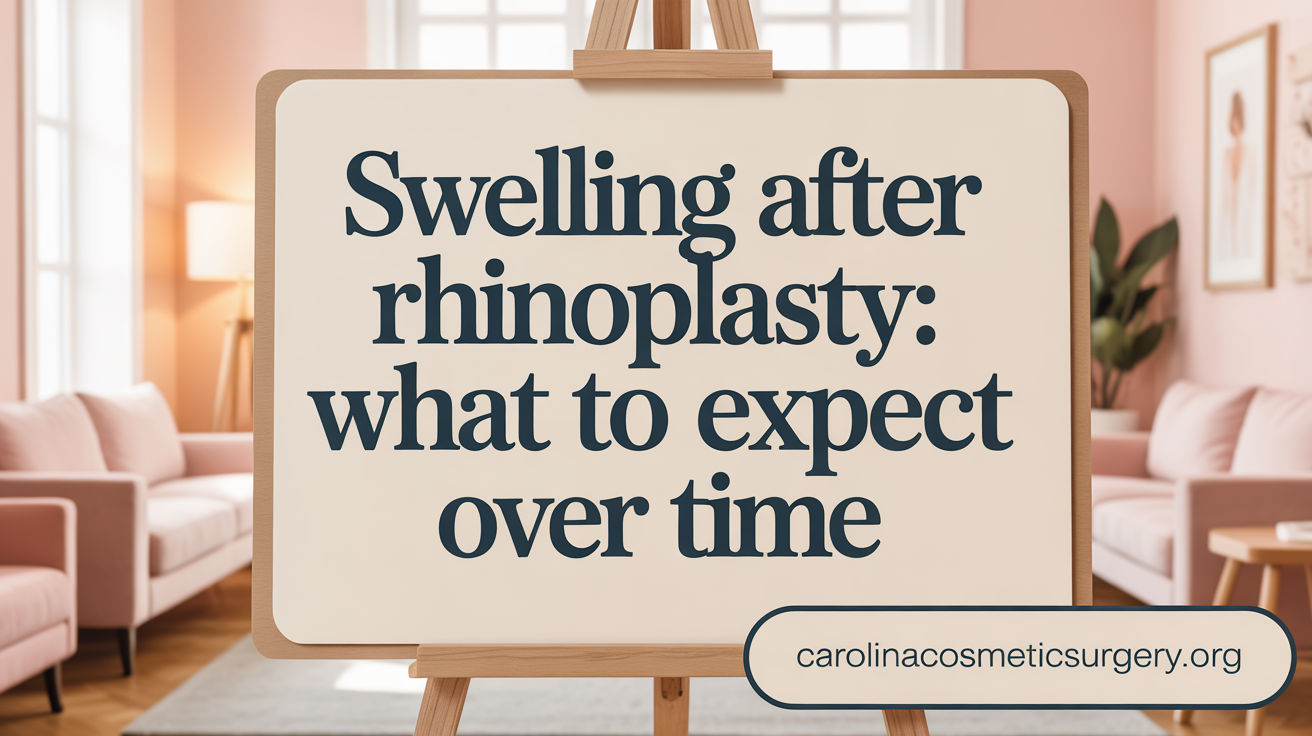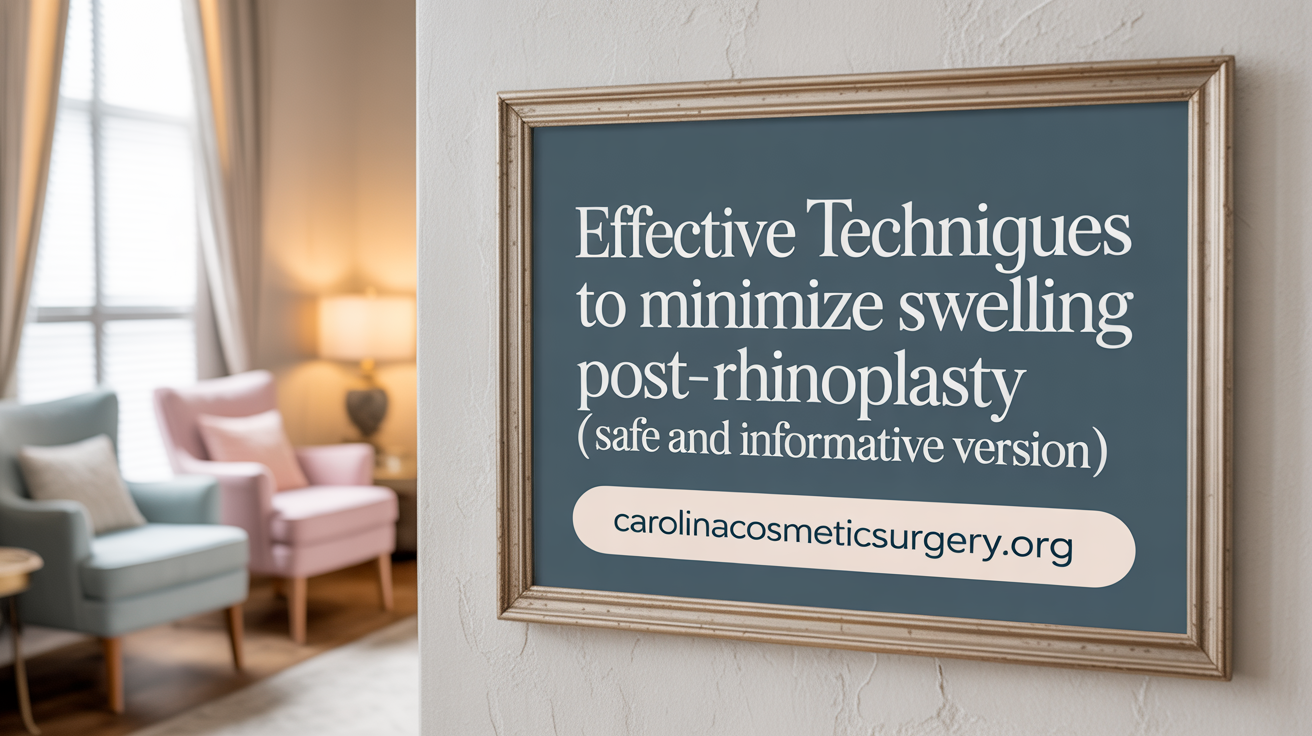Understanding the Path to a Smooth Rhinoplasty Recovery
Rhinoplasty is a surgical journey that reshapes the nose for both aesthetic and functional improvements. However, the recovery phase can present challenges, particularly managing swelling and breathing discomfort. This article provides comprehensive guidance on what patients can expect during rhinoplasty recovery, effective strategies to reduce swelling, improve breathing, and recognize when to seek medical attention. Armed with these insights, patients can navigate their healing with informed patience and proactive care.
The Natural Course of Swelling After Rhinoplasty and Its Timeline

What is the typical timeline for swelling to subside after rhinoplasty?
Swelling after rhinoplasty begins immediately post-surgery, with the most noticeable effects occurring in the first 2-3 days. During this initial phase, swelling often peaks around days 2 to 4, accompanied by bruising and nasal congestion. Most patients observe significant reduction in swelling and bruising by the end of the first week, especially after splints and sutures are removed.
By weeks 2 to 3, the swelling continues to diminish visibly, and breathing tends to improve as internal tissues settle. The majority of external swelling, especially on the nasal bridge and dorsal area, subsides within the second to fourth week. However, some internal swelling and tissue inflammation inside the nose may persist for longer, impacting nasal airflow temporarily.
Most swelling is expected to decrease substantially within 3 to 4 weeks, allowing patients to return to light activities and observe notable aesthetic improvements. Nonetheless, minor residual swelling and tissue reorganization can last several months.
Complete healing and tissue settling, including the resolution of all swelling and final contouring, typically take between 6 to 9 months. During this period, subtle changes in shape occur as swelling gradually diminishes, with the nose achieving the final refined appearance. In some cases, especially in individuals with thicker skin or extensive restructuring, residual swelling and fine tissue adjustments can persist up to a year following surgery.
Techniques and Lifestyle Measures to Effectively Reduce Swelling

How can I reduce swelling after rhinoplasty, particularly around two weeks post-operation?
To effectively reduce swelling two weeks after rhinoplasty, continued elevation of the head during sleep is essential. Using wedge pillows or sleeping in a semi-reclined position helps facilitate lymphatic drainage and reduces fluid buildup. Applying cold compresses to the cheeks—avoiding direct contact on the nose—is beneficial. These compresses should be applied in 20-minute sessions every 20 minutes for the first 48 hours, then as needed, to help lessen residual swelling and discomfort.
Maintaining good hydration by drinking plenty of water aids in flushing out excess fluids and supports healing. It is crucial to avoid strenuous activities, heavy lifting, and any actions that can increase blood flow to the face. These activities can extend swelling duration and interfere with proper recovery.
Following your surgeon’s post-operative instructions—such as maintaining nasal taping if advised, refraining from smoking and alcohol consumption, and managing incision care—further promotes optimal healing. Consistent adherence to these measures helps reduce swelling effectively and ensures a smooth recovery process.
What are effective strategies to alleviate swelling and congestion following rhinoplasty?
Alleviating swelling and nasal congestion post-rhinoplasty involves several practical steps. Keeping your head elevated during sleep, using a wedge pillow or reclining chair, helps drain excess fluids and reduces facial puffiness.
Applying cold compresses to the cheeks, not directly on the nose, for 10-20 minute intervals during the first few days can significantly diminish swelling, bruising, and pain. This method constricts blood vessels and minimizes fluid accumulation.
It is vital to avoid strenuous activities, heavy lifting, and vigorous exercises for at least 2 to 3 weeks to prevent increasing blood flow and swelling.
Following your surgeon’s instructions regarding medication use, sun protection, and avoiding nose blowing are crucial. Drinking plenty of water and maintaining a healthy diet rich in vitamins and minerals provide essential nutrients for healing.
Attending scheduled follow-up appointments allows your surgeon to monitor healing progress and address any concerns promptly. Incorporating these strategies can effectively reduce swelling and congestion, leading to a more comfortable recovery.
What supplements can support reduction of swelling after rhinoplasty?
Certain supplements may aid in reducing swelling and promoting healing after rhinoplasty. Bromelain, an enzyme derived from pineapples, is commonly used to decrease inflammation and swelling.
Vitamin C supports collagen production, tissue repair, and immune function, which are vital during healing. Arnica Montana, available in topical or oral forms, has been traditionally used to minimize bruising and swelling; however, oral supplementation should be undertaken with medical advice.
Zinc and omega-3 fatty acids also possess anti-inflammatory properties that can support recovery. Adequate protein intake is essential for tissue repair.
It’s important to consult with your healthcare provider before starting any new supplements, especially to avoid interactions with medications or contraindications specific to your health status.
In summary, combining proper aftercare techniques with suitable supplements, under medical guidance, can effectively reduce swelling, improve comfort, and enhance overall healing after rhinoplasty.
Breathing Difficulties After Rhinoplasty: Causes and Improvement Timeline

Why does mouth breathing occur after rhinoplasty?
Mouth breathing is common immediately following rhinoplasty because of nasal congestion caused by swelling and surgical dressings inside the nostrils. This congestion can block airflow through the nose, forcing patients to breathe through their mouth. During the first week or so, this can result in dryness and discomfort in the mouth and throat.
What causes nasal congestion after rhinoplasty?
Nasal congestion primarily results from swelling inside the nose and the presence of packing or splints used during surgery. These modifications help maintain the nasal structure but temporarily obstruct airflow. Additionally, internal tissue swelling narrows the nasal passages, further impairing breathing.
How long does it usually take for breathing to improve?
The improvement in breathing after rhinoplasty typically begins within 1 to 2 weeks. As swelling and bruising decrease, airflow improves noticeably, especially after splints and sutures are removed around day 7.
In the following weeks, residual swelling may cause continued mild congestion. Full recovery of normal nasal function, with optimal breathing, can take up to a year, as tissues settle and all swelling subsides. Patience is essential, as nasal shape and airflow tend to improve gradually over many months.
How do structural changes affect breathing?
Structural modifications, such as repositioning cartilage or adjusting the septum during rhinoplasty, influence airflow. Right after surgery, these changes might temporarily cause swelling or internal scarring, which can induce congestion. Correcting septal deviations or turbinates often improves breathing long-term but may cause initial temporary blockage.
Why is follow-up with the surgeon important?
Regular follow-up appointments are crucial for monitoring healing progress, removing splints or sutures, and addressing any breathing concerns. Your surgeon can evaluate whether persistent congestion might be due to swelling, structural issues, or complications needing further intervention.
What signs indicate I need medical attention for breathing problems?
Seek immediate medical care if you experience severe or worsening shortness of breath, significant pain not relieved by medication, bleeding that does not stop, or signs of infection such as fever, foul nasal discharge, or increasing swelling.
Understanding that congestion and breathing difficulties are normal in early recovery helps set realistic expectations. Proper aftercare, including nasal rinses, head elevation, and avoiding irritants, supports easier breathing and smoother healing.
Post-Operative Care Essentials for Optimizing Healing and Comfort

Importance of following surgeon’s instructions
Adhering to your surgeon’s specific post-operative guidelines is crucial for a smooth recovery. This includes instructions on medication use, wound care, and activity restrictions. Proper adherence minimizes complications and supports optimal healing.
Medication adherence and pain management
Taking prescribed medications such as ibuprofen, acetaminophen, or supplements like Vitamin C, arnica, and bromelain can help reduce swelling and discomfort. These medications should be taken exactly as directed to manage pain effectively.
Avoiding nose blowing and facial pressure
For at least a week after surgery, avoid blowing your nose to prevent disrupting healing tissues. Instead, gently wipe with a tissue if necessary. Avoid applying pressure or wearing glasses that rest on your nose for about four weeks to prevent movement or damage to the healing nasal structures.
Protecting the nose from trauma and sun
Shield your nose from direct sun exposure using SPF, hats, and UV protection to prevent skin damage. Protecting the nose from accidental bumps or pressure is vital during the entire healing process.
Maintaining cleanliness and wound care
Keep the surgical area clean and follow your surgeon’s instructions regarding wound care. This helps prevent infections and promotes better healing. Avoid activities that can introduce dirt or germs to the surgical site.
Rest and activity modifications
Rest is essential in the initial days—preferably with your head elevated on 2 or 3 pillows—to reduce swelling and support drainage. Avoid strenuous activities, heavy lifting, and exercises that increase blood flow for at least 2 to 4 weeks. Gradually resume physical activity as advised by your doctor.
Scheduled follow-up appointments
Regular follow-up visits allow your surgeon to monitor healing progress, remove sutures or splints, and address any concerns early. These appointments help ensure the nose heals correctly and that you're on track for the best results.
By carefully following these post-operative care steps, patients can enhance healing, minimize discomfort, and achieve the best possible outcome from rhinoplasty.
Recognizing Normal Versus Problematic Recovery Signs
 During the recovery period after rhinoplasty, certain symptoms are expected and indicate normal healing processes. Swelling, nasal congestion, mild discomfort, and a gradual improvement in breathing are common. Swelling may peak within the first 48 hours and start to diminish over the course of several weeks. Breathing difficulties tend to improve significantly within two to three months, although some residual congestion may last up to 6 months or longer.
During the recovery period after rhinoplasty, certain symptoms are expected and indicate normal healing processes. Swelling, nasal congestion, mild discomfort, and a gradual improvement in breathing are common. Swelling may peak within the first 48 hours and start to diminish over the course of several weeks. Breathing difficulties tend to improve significantly within two to three months, although some residual congestion may last up to 6 months or longer.
It is important to distinguish normal discomforts from signs of complications. While mild pain, swelling, and congestion are typical, persistent or worsening issues must be monitored carefully. For example, if swelling becomes excessive or continues to increase after the initial weeks, or if breathing remains labored beyond the expected timeframe, these could be warning signs of swelling or structural issues requiring medical attention.
Signs of concern include severe or increasing swelling, persistent or intense pain not relieved by medication, redness, warmth around the nose, or discharge linking to infection. Abnormal changes in the shape of the nose—such as asymmetry or unexpected deformity—are also problematic. In addition, a sudden or severe difficulty in breathing, pass-out episodes, chest pain, or coughing up blood require urgent medical evaluation.
Monitoring changes in nasal shape and breathing abilities is essential. Any unusual development should prompt timely communication with your surgeon. Regular follow-up appointments allow your doctor to assess healing and address any concerns early.
Ultimately, staying attentive to your body's signals and maintaining clear communication with your healthcare provider are vital for a safe and healthy recovery. If you experience symptoms that seem out of the ordinary, do not hesitate to seek medical advice to prevent complications and ensure proper healing.
Long-Term Recovery Outlook and Patient Expectations

How does rhinoplasty healing progress over time?
Rhinoplasty healing is a gradual process that unfolds over several months. Initially, swelling and bruising peak within the first few days to a week. Most noticeable improvements occur within the first 2 to 4 weeks, but some residual swelling can linger. Over months, the body's natural healing reduces swelling, and the nose begins to settle into its final shape.
As tissues continue to recover, patients will observe ongoing refinement, often appreciating the full results approximately one year after surgery. This lengthy healing period allows the nose to gradually assume its optimized appearance, with the final shape most visibly stable after this time.
When can the final nose shape be seen?
While significant changes can be seen within a few months, the complete transformation is usually apparent around 12 months post-surgery. This timeline accounts for the slow resolution of swelling, especially at the nasal tip and lower nose, which tend to hold residual swelling the longest. Patients should expect patience during this period, as the nose continues to refine even after initial improvements.
Do swelling and numbness persist long-term?
Residual mild swelling can last for several months, especially in cases with thicker skin or more extensive procedures. Some patients may also experience sensations like numbness or tightness, which typically resolve gradually over months.
In rare cases, numbness or altered sensation may persist longer, but most symptoms diminish with ongoing healing. Regular communication with the surgeon helps monitor and manage these symptoms.
Why patience and adherence to aftercare matter
Achieving optimal results hinges on patience and compliance with post-operative care. Keeping the head elevated, avoiding strenuous activities, protecting the nose from trauma, and following medication schedules are vital.
Adhering to these guidelines reduces swelling, prevents complications, and supports tissue healing. Recognizing that swelling can linger and shape changes are gradual fosters realistic expectations.
Is revision surgery sometimes needed?
Although most patients are satisfied with their results, some may require revision procedures if residual swelling persists or if aesthetic or functional issues remain unresolved. Revision rhinoplasty can address these concerns, but it is typically planned after full healing and stabilization of the nose, usually after at least one year.
Overall outcomes and satisfaction
With proper care, most patients enjoy positive outcomes, including improved nasal appearance and breathing function. Though the healing timeline is lengthy, patience and diligent aftercare play essential roles in achieving satisfying, long-lasting results.
Moving Forward with Confidence in Rhinoplasty Recovery
Recovery from rhinoplasty is a delicate balance of managing swelling, supporting nasal function, and following a detailed care plan. Understanding the typical recovery milestones and what to expect helps patients feel prepared and reassured during the process. By embracing strategies such as head elevation, cold compress application, medication adherence, and protecting the nose from strain, individuals actively promote optimal healing and improved breathing. Recognizing when symptoms are within normal ranges or require medical attention is key to avoiding complications. Ultimately, patience and close cooperation with your surgeon pave the way for achieving the best aesthetic and functional outcomes from your rhinoplasty procedure.
References
- Recovery Tips for Rhinoplasty Swelling: Management Techniques
- Rhinoplasty: What to Expect at Home - MyHealth Alberta
- What Is the Rhinoplasty Recovery Timeline?
- What Are the Most Common Rhinoplasty Recovery Challenges?
- 10 Tips For A Faster Rhinoplasty Recovery
- Rhinoplasty Recovery Timeline: Week-by-Week Breakdown
- How To Reduce Swelling After Rhinoplasty - Dr Shahidi
